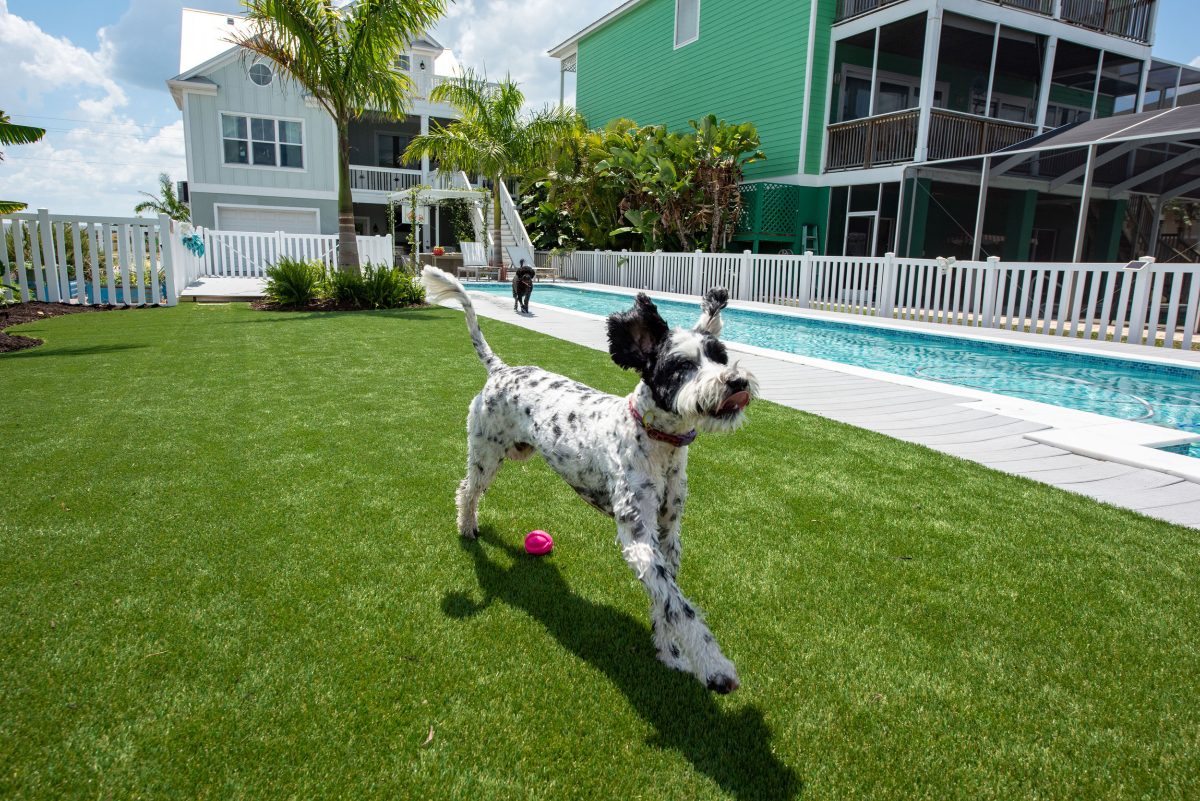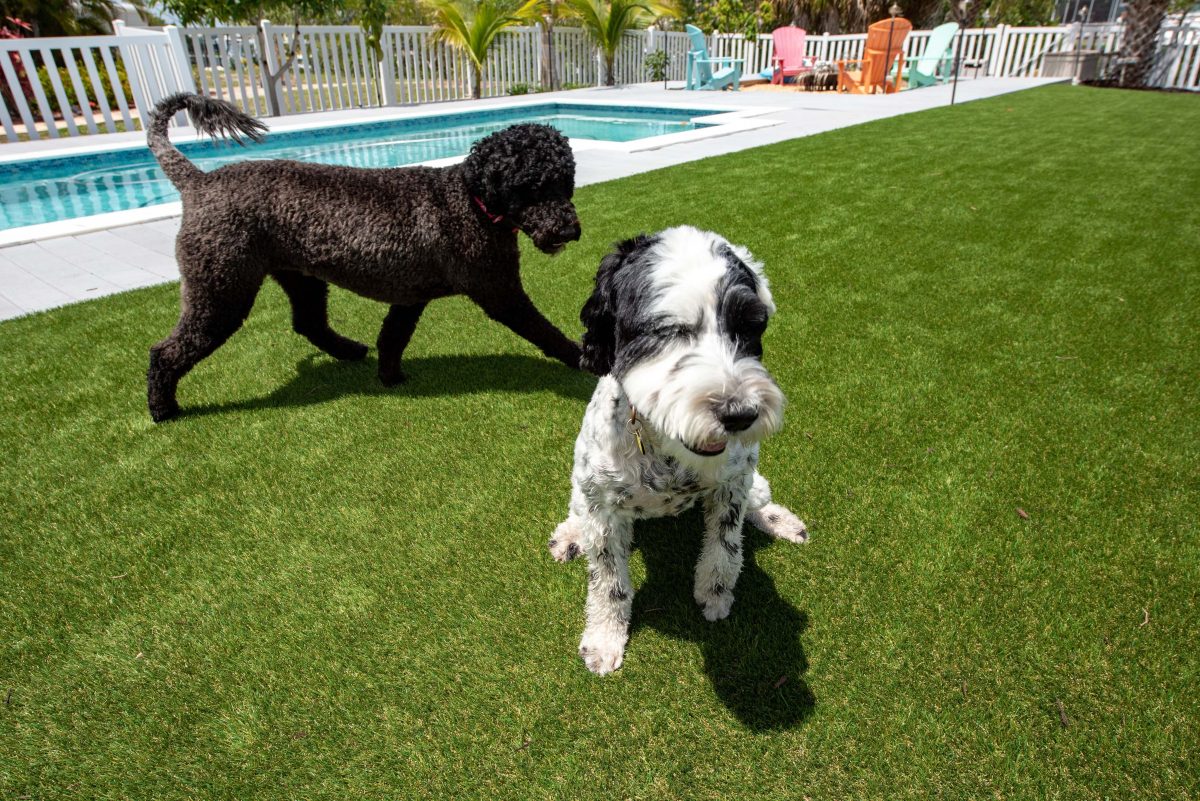Every owner of a synthetic lawn should consider purchasing a good Artificial turf cleaner or at least be aware of its benefits. It's inevitable that your lawn will require cleaning, especially if you have dogs or pets that urinate or deposit solid waste on it. The popularity of artificial turf lawns is on the rise, in part due to their ultra-low maintenance, but there are still some steps you should take to keep it clean and hygienic throughout the year, particularly if you have children and pets.

Artificial turf cleaner
The best way to prevent harmful organisms or bacteria from taking hold in your grass is to promptly remove solid waste and rinse the grass with a garden hose to eliminate urine. This is especially crucial if you have dogs or pets that frequently use the lawn. Besides regular rinsing, there are other options for keeping the grass clean and deodorized, including using detergents, vinegar, or a potent enzyme cleaner specifically designed to eliminate potentially harmful bacteria. We'll delve further into how to clean Artificial turf below.

Pet-safe Artificial turf Cleaner
There are numerous pet-safe Artificial turf cleaners for dogs available in the market today. While this variety is advantageous because it offers consumers multiple choices, it can also be perplexing when selecting a cleaner that's strong enough to eliminate urine odors yet safe for everyone using the lawn, including children and dogs. Some Artificial turf cleaners for dogs contain potent enzymes that target bacteria found in urine and feces. These enzymes are robust enough to eradicate bacteria while remaining gentle enough for areas frequented by children and dogs, and they won't harm your grass.
Dog-friendly Artificial turf cleaners come in two primary forms. One is a convenient spray bottle containing a pre-mixed liquid, usually with a ratio of 1:10, which is a concentrate of enzyme cleaner mixed with water. A noteworthy product worth considering is an Artificial turf spray cleaner, perfect for spot cleaning and small areas used by dogs or pets as a bathroom. They are effective for cleaning and breaking down organic substances such as feces, urine, blood, sweat, and vomit. Billions of naturally occurring bioenzymes eliminate odors at the source and break down organic waste.
Another type of Artificial turf cleaner is a high-strength cleaning concentrate. An Artificial turf cleaning concentrate is ideal for large areas frequently used by dogs. Kennels, dog runs, or yards with multiple dogs will find using a concentrate beneficial and cost-effective compared to a pre-mixed spray cleaner. Concentrate application is best done using a hose-end sprayer with adjustable mixture ratio settings.
Simple Green Outdoor Odor Eliminator for Pets
Rapidly eliminates odors caused by urine, feces, vomit, and organic matter.
If you click this link and make a purchase, we may earn a commission.
Artificial turf pet odor eliminator
How to Clean Artificial turf Step by Step
Utilizing a potent Artificial turf odor eliminator works by eradicating the bacteria responsible for the pungent smell. Odors can arise from urine accumulating in the Artificial turf infill over time or residual fecal particles. A high-quality cleaner containing active enzymes is ideal for killing bacteria and the accompanying odor, making it suitable for cleaning lawns and even Artificial turf dog areas. Let's explore the fundamental steps for cleaning Artificial turf urine smells and other forms of organic matter.
Remove Large Debris
Clearing debris from your artificial lawn is crucial to prevent organic matter from settling between the grass blades. As this material settles, it can lead to issues such as weed growth, moss, and fungi harboring odor-causing bacteria. Debris can be effortlessly removed using a blower or refreshed with a power broom for a more thorough clean that lifts debris from the grass backing.
It's best to start from one corner of the area and work your way towards the opposite corner. If using a power brush, work in the opposite direction of the blade slant. Blooming the blades is a pivotal part of routine Artificial turf maintenance. The aim is to eliminate as much organic debris as possible while fluffing up the grass, leaving it in a state conducive to optimal cleaning.
If you have pets, especially dogs that use the grassy area as a bathroom, be sure to clear all feces. Any solid waste not cleared before rinsing can become lodged in the grass thatch layer and cause issues.
Garland Roll & Comb 502E Artificial turf Power Brush
Cleans and collects debris from Artificial turf, including leaves, pine needles, and pet hair.
If you click this link and make a purchase, we may earn a commission.
Artificial turf power broom
2) Rinse with a Garden Hose
Thoroughly rinsing with a garden hose is a crucial step before using an Artificial turf cleaner. Pay attention to areas frequented by pets or areas prone to becoming soiled, such as those near a sandbox or garden. The goal is to target dirt, urine buildup, or other organic matter that could lead to other problems. Aim to spray every square foot of the grass, even where it doesn't appear dirty, as urine might be present even when not visible.
A pressure washer can be used instead of a garden hose, but be cautious not to displace infill material when doing so. It's easy to overspray, disrupt infill material, or even damage the grass.
Check for Weeds, Moss, and Mold
After brushing and rinsing the grass, it's the perfect time to inspect for the presence of weeds, moss, or fungal growth. While a properly installed Artificial turf installation will prevent most organic vegetation like weeds from growing, they might develop over time. If you find any weeds, moss, or fungus, take note of their locations and apply a little extra Artificial turf cleaner to address the issue.
Inspect for Stains or Residue
Examine the grass for stains or any foreign substances that shouldn't be there. This could include paint, oil, tree sap, or even food left behind by a child or dog. While each substance requires a different approach, the goal is to remove the majority of the substance using appropriate means and then eliminate the residue. This can be accomplished using a stiff bristle push broom and materials like baking soda, dry ice, and even white vinegar, as we'll discuss in more detail below.
Food and drink spills can be cleaned with a natural, mild, eco-friendly cleaner. For optimal results, clean the area as soon as possible after the spill. Rinse the area afterward to remove cleaner residue and avoid using chemicals that could corrode or discolor the grass. Tree sap, candy, and sticky gum can be challenging to remove from Artificial turf, but it's possible with some effort. A good method is to freeze the substance using dry ice or an aerosol refrigerant and then carefully break it away.
Motor oils, grease, paints, and other stubborn substances can be effectively cleaned using mineral spirits or a mild detergent solution mixed with warm water.
Tidy Tools Large 18" Push Broom with Alloy Handle
Stiff bristle push broom ideal for cleaning Artificial turf.
If you click this link and make a purchase, we may earn a commission.
Broom for Artificial turf
5) Enzyme Cleaner Application
After dealing with stubborn stains (if any), it's time to thoroughly clean the entire grass with an Artificial turf enzyme cleaner. The most efficient way to cover a large area in a short amount of time is to use a hose-end sprayer with an adjustable ratio dial to set the desired concentration. Apply the enzyme cleaner concentrate evenly across the entire yard, but you can apply more in areas with high urine or feces content to ensure sufficient cleaning agent is applied.
This is the final step in cleaning Artificial turf and should take about 15-20 minutes for every 1,000 square feet of grass. The cleaner should provide dilution recommendations and the coverage area for the size of the hose-end sprayer container. As you become familiar with your dogs' habits, the time of year, and other variables, you'll develop a good understanding of how much enzyme cleaner is needed to neutralize urine odors and disinfect the area.
Cleaning Artificial turf with Vinegar
Cleaning Artificial turf with a mixture of vinegar and water is an effective method for killing and preventing bacteria. While bacteria is rarely found in properly installed and maintained synthetic lawns, it can sometimes be present in areas like dog runs, kennels, and spaces where food is prepared or served. If the grass is installed with a suitable sub-layer that allows proper drainage and an antimicrobial infill, it becomes nearly impossible for bacteria to thrive.
The most common method of cleaning with vinegar is to mix equal parts of vinegar and water at a 1:1 ratio. Small areas can be cleaned using a sponge and cloth, while for larger areas, it's best to use a spray bottle. Scrub the area as needed and then rinse with clean water from a garden hose to wash away both the vinegar and any urine, food, etc. through the grass. If you're cleaning a larger backyard area, we recommend using a hose-end sprayer with an attached mixing bottle.
45% Pure Vinegar Concentrate Grade 1 Gallon
Biodegradable concentrated cleaning vinegar for Artificial turf.
If you click this link and make a purchase, we may earn a commission.
Vinegar concentrate cleaner
Frequently Asked Questions about Artificial turf Cleaners
If you have specific questions about Artificial turf cleaners, be sure to ask one of our experts. There are numerous cleaning products available today, and the choice often boils down to selecting one you trust or one that's accessible in your area. While it's unlikely you'll encounter bacteria issues, it could become a problem if dogs frequently urinate in a specific area, if drainage is inadequate, or if an antimicrobial infill wasn't used. These are factors to consider when installing Artificial turf for dogs.
Can you clean Artificial turf?
Yes, you can clean Artificial turf. A basic clean can be done by rinsing it with clean water from a garden hose. For a deeper clean, we recommend using an enzyme cleaner designed for Artificial turf, which can eliminate bacteria, odors, and even provide a pleasant scent.
